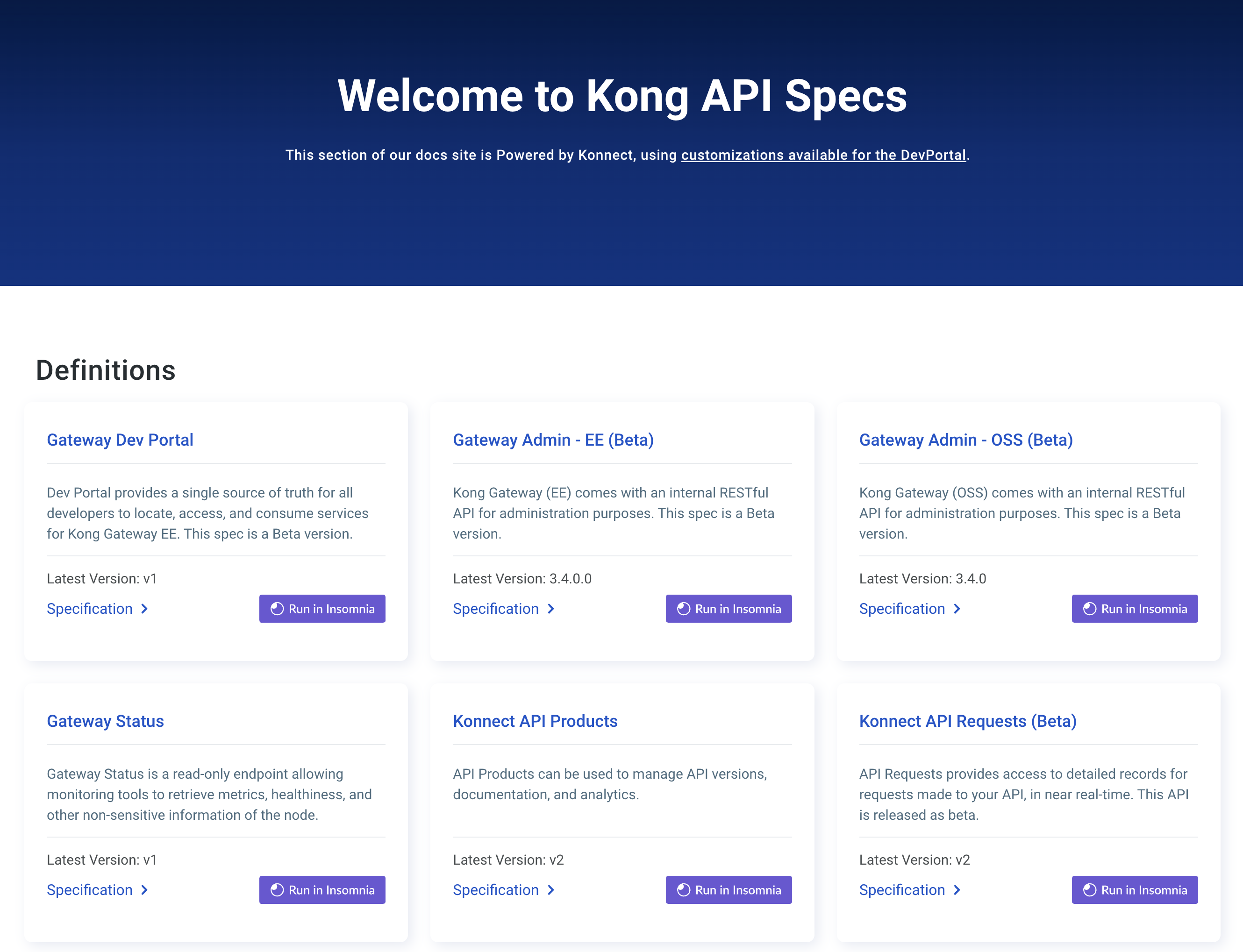このページは、まだ日本語ではご利用いただけません。翻訳中です。
Horizontally autoscale workloads using Prometheus and Prometheus adapter
Kong Gateway Operator can be integrated with Prometheus and prometheus-adapter in order to use Kong Gateway latency metrics to autoscale workloads based on their metrics.
Install Prometheus
Note: You can reuse your current Prometheus setup and skip this step but please be aware that it needs to be able to scrape Kong Gateway Operator’s metrics (e.g. through
ServiceMonitor) and note down the namespace in which it’s deployed.
-
Add the
prometheus-communityhelm charts:helm repo add prometheus-community https://prometheus-community.github.io/helm-charts helm repo update -
Install Prometheus via
kube-prometheus-stackhelm chart:helm upgrade --install --create-namespace -n prometheus prometheus prometheus-community/kube-prometheus-stack
Create a ServiceMonitor to scrape Kong Gateway Operator
To make Prometheus scrape Kong Gateway Operator’s /metrics endpoint, we’ll need to create a ServiceMonitor:
echo '
apiVersion: monitoring.coreos.com/v1
kind: ServiceMonitor
metadata:
labels:
release: prometheus
name: gateway-operator
namespace: kong-system
spec:
endpoints:
- port: https
scheme: https
path: /metrics
bearerTokenFile: /var/run/secrets/kubernetes.io/serviceaccount/token
tlsConfig:
insecureSkipVerify: true
selector:
matchLabels:
control-plane: controller-manager ' | kubectl apply -f -
After applying the above manifest you can check one of the metrics exposed by Kong Gateway Operator to verify that the scrape config has been applied.
To access the Prometheus UI, create a port-forward and visit http://localhost:9090
kubectl port-forward service/prometheus-kube-prometheus-prometheus 9090:9090 -n prometheus
This can be verified by going to your Prometheus UI and querying e.g.:
up{service=~"kgo-gateway-operator-metrics-service"}
Prometheus metrics can take up to 2 minutes to appear
Install prometheus-adapter
The prometheus-adapter package makes Prometheus metrics usable in Kubernetes.
To deploy prometheus-adapter you’ll need to decide what time series to expose so that Kubernetes can consume it.
Note: Kong Gateway Operator enriches specific metrics for use with
prometheus-adapter. See the overview for a complete list.
Create a values.yaml file to deploy the prometheus-adapter helm chart.
This configuration calculates a kong_upstream_latency_ms_60s_average metric, which exposes a 60s moving average of upstream response latency:
prometheus:
# Update this value if Prometheus is installed in a different namespace
url: http://prometheus-kube-prometheus-prometheus.prometheus.svc
rules:
default: false
custom:
- seriesQuery: '{__name__=~"^kong_upstream_latency_ms_(sum|count)",kubernetes_namespace!="",kubernetes_name!="",kubernetes_kind!=""}'
resources:
overrides:
exported_namespace:
resource: "namespace"
exported_service:
resource: "service"
name:
as: "kong_upstream_latency_ms_60s_average"
metricsQuery: |
sum by (exported_service) (rate(kong_upstream_latency_ms_sum{<<.LabelMatchers>>}[60s:10s]))
/
sum by (exported_service) (rate(kong_upstream_latency_ms_count{<<.LabelMatchers>>}[60s:10s]))
Install prometheus-adapter using Helm:
helm upgrade --install --create-namespace -n prometheus --values values.yaml prometheus-adapter prometheus-community/prometheus-adapter
Send traffic
To trigger autoscaling, run the following command in a new terminal window. This will cause the underlying deployment to sleep for 100ms on each request and thus increase the average response time to that value.
while curl -k "http://$(kubectl get gateway kong -o custom-columns='name:.status.addresses[0].value' --no-headers -n default)/echo/shell?cmd=sleep%200.1" ; do sleep 1; done
Keep this running while we move on to next steps.
Verify metrics are exposed in Kubernetes
When all is configured you should be able to see the metric you’ve configured in prometheus-adapter exposed via the Kubernetes Custom Metrics API:
kubectl get --raw '/apis/custom.metrics.k8s.io/v1beta1/namespaces/default/services/echo/kong_upstream_latency_ms_60s_average' | jq
Note: The
prometheus-adaptermay take up to 2 minutes to populate the custom metrics
This should result in:
{
"kind": "MetricValueList",
"apiVersion": "custom.metrics.k8s.io/v1beta1",
"metadata": {},
"items": [
{
"describedObject": {
"kind": "Service",
"namespace": "default",
"name": "echo",
"apiVersion": "/v1"
},
"metricName": "kong_upstream_latency_ms_60s_average",
"timestamp": "2024-03-06T13:11:12Z",
"value": "102312m",
"selector": null
}
]
}
Note:
102312mis a Kubernetes way of expressing numbers as integers.valuerepresents the latency in microseconds, and is approximately equivalent to 102 milliseconds (ms).
Use exposed metric in HorizontalPodAutoscaler
When the metric configured in prometheus-adapter is available through Kubernetes’ Custom Metrics API
we can use it in HorizontalPodAutoscaler to autoscale our workload: specifically the echo Deployment.
This can be done by using the following manifest, which will scale the underlying echo Deployment between 1 and 10 replicas, trying to keep the average latency across last 60s at 40ms.
echo '
apiVersion: autoscaling/v2
kind: HorizontalPodAutoscaler
metadata:
name: echo
namespace: default
spec:
scaleTargetRef:
apiVersion: apps/v1
kind: Deployment
name: echo
minReplicas: 1
maxReplicas: 10
behavior:
scaleDown:
stabilizationWindowSeconds: 1
policies:
- type: Percent
value: 100
periodSeconds: 10
scaleUp:
stabilizationWindowSeconds: 1
policies:
- type: Percent
value: 100
periodSeconds: 2
- type: Pods
value: 4
periodSeconds: 2
selectPolicy: Max
metrics:
- type: Object
object:
metric:
name: "kong_upstream_latency_ms_60s_average"
describedObject:
apiVersion: v1
kind: Service
name: echo
target:
type: Value
value: "40" ' | kubectl apply -f -
Observe Kubernetes SuccessfulRescale events
You can watch SuccessfulRescale events using the following kubectl command:
kubectl get events -n default --field-selector involvedObject.name=echo --field-selector involvedObject.kind=HorizontalPodAutoscaler -w
If everything went well we should see the SuccessfulRescale events:
12m Normal SuccessfulRescale horizontalpodautoscaler/echo New size: 2; reason: Service metric kong_upstream_latency_ms_60s_average above target
12m Normal SuccessfulRescale horizontalpodautoscaler/echo New size: 4; reason: Service metric kong_upstream_latency_ms_60s_average above target
12m Normal SuccessfulRescale horizontalpodautoscaler/echo New size: 8; reason: Service metric kong_upstream_latency_ms_60s_average above target
12m Normal SuccessfulRescale horizontalpodautoscaler/echo New size: 10; reason: Service metric kong_upstream_latency_ms_60s_average above target
Then when latency drops (when you stop sending traffic with the curl command) you should observe the SuccessfulRescale events scaling your workloads down:
4s Normal SuccessfulRescale horizontalpodautoscaler/echo New size: 1; reason: All metrics below target












